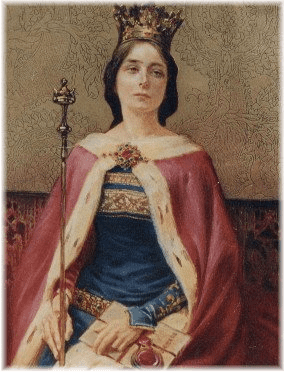Role Saint Name Balthild Balthild | Spouse Clovis II (m. 649 AD) | |
 | ||
Venerated in Roman Catholic Church
Eastern Orthodox Church Canonized c. 880 by Pope Nicholas I Major shrine Abbey of Chelles outside of Paris Feast The Roman martyrology says her feast day is January 26; France celebrates it January 30. Died January 30, 680 AD, Chelles, France Children Chlothar III, Childeric II, Theuderic III Grandchildren Clovis III, Chilperic II, Childebert III, Clovis IV, Chlothar IV, Bertrada of Prum, Chrotlind Great grandchildren Childeric III, Dagobert III Similar People Clovis II, Childeric II, Theuderic III, Dagobert I, Chilperic II | ||
Great Women of Old England: Queen Balthild
Saint Balthild of Ascania ( ; Old English: Bealdhild, 'bold sword' or 'bold spear; around 626 – January 30, 680), also called Bathilda, Baudour, or Bauthieult, was queen consort of Burgundy and Neustria by marriage to Clovis II, the king of Burgundy and Neustria (639–658), and regent during the minority of her son. Her hagiography was intended to further her successful candidature for sainthood.
Contents

Tradition represents her as an Anglo-Saxon who was originally of elite birth, perhaps a relative of Ricberht of East Anglia, the last pagan king of East Anglia, although Pierre Fournet regards this as doubtful. Ricberht was ousted by Sigeberht, who had spent time as an exile in the Frankish court, during which he had been converted to Christianity. Sigeberht was established as the rightful heir to the throne with Frankish help. Balthild was sold into slavery as a young girl and served in the household of Erchinoald, the mayor of the palace of Neustria to Clovis.
Hagiographic tradition
According to Vita S. Bathildis, Balthild was born circa 626–627. She was beautiful, intelligent, modest and attentive to the needs of others. Erchinoald, whose wife had died, was attracted to Balthild and wanted to marry her, but she did not want to marry him. She hid herself away and waited until Erchinoald had remarried. Later, possibly because of Erchinoald, Clovis noticed her and asked for her hand in marriage.
Even as queen, Balthild remained humble and modest. She is famous for her charitable service and generous donations. From her donations, the abbeys of Corbie and Chelles were founded; it is likely that others such as Jumièges, Jouarre and Luxeuil were also founded by the queen. She provided support for Saint Claudius of Besançon and his abbey in the Jura Mountains.
Balthild bore Clovis three children, all of whom became kings: Clotaire, Childeric and Theuderic.
When Clovis died (between 655 and 658), his eldest son Clotaire succeeded to the throne. His mother Balthild acted as the queen regent. As queen, she was a capable stateswoman. She abolished the practice of trading Christian slaves and strove to free children who had been sold into slavery. This claim is corroborated by Jane Tibbetts Schulenburg, who mentions that Balthild and Saint Eloi (who was also known as Eligius, according to Dado) “worked together on their favorite charity, the buying and freeing of slaves”. After her three sons reached adulthood and had become established in their respective territories (Clotaire in Neustria, Childeric in Austrasia, and Theuderic in Burgundy), Balthild withdrew to her favourite Abbey of Chelles near Paris.
Balthild died on January 30, 680, and was buried at the Abbey of Chelles, east of Paris. Her Vita was written soon after her death, probably by one of the community of Chelles. The Vita Baldechildis/Vita Bathildis reginae Francorum in Monumenta Germania Historica, Scriptores Rerum Merovincarum, as with most of the vitae of royal Merovingian-era saints, provides some useful details for the historian. Her official cult began when her remains were transferred from the former abbey to a new church, in 833, under the auspices of Louis the Pious. Balthild was canonised by Pope Nicholas I, around 200 years after her death.
Balthild seal matrix
A gold seal matrix, which was originally attached to a seal-ring, was uncovered in 1999 by a metal detector in a field in Postwick, 4.5 miles (7.2 km) east of Norwich, in Norfolk. One side shows a woman's face and her name BALDAHILDIS in Frankish lettering. The other side portrays two naked figures, a man and a woman, embracing one another beneath a cross.
In Merovingian Gaul, one side of the seal was intended to be used with official documents. The other side would have been used only for private papers. It is uncertain why the seal matrix came to East Anglia. It may have been a gift, or a representative of Balthild may have worn it as a form of identification. It has also been suggested that the seal matrix was returned to Balthild's kin after she died. Paul Fouracre of the University of Manchester speculates that the seal may belong to a different Baldahildis entirely. The seal matrix is in the keeping of the Norwich Castle Museum.
